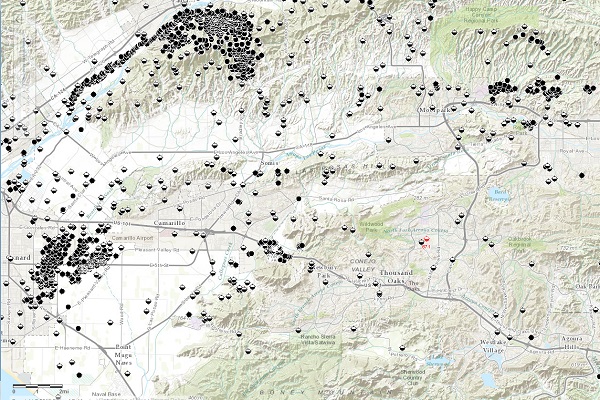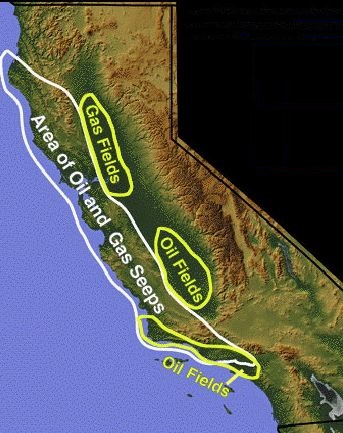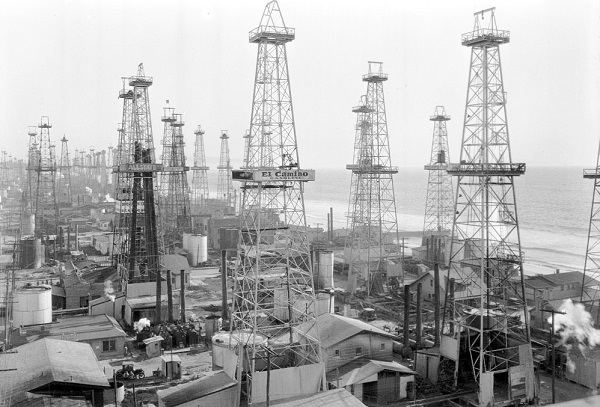
Twelve miles inland of the Pacific Ocean in the Conejo Valley, Thousand Oaks, California, has more than 125,000 residents “nestled neatly within a picturesque plateau, rimmed by scenic hills, mountains and trees,” notes a local realtor.
Conejo Hills Oil Company’s history is the story of a single California well, spudded by one company and drilled for years by many others in what today is a residential neighborhood of Thousand Oaks, one the wealthiest cities in America.
This lush valley region – about 35 miles from Los Angeles on the stagecoach route to Santa Barbara – was part of the Karn Pederson Ranch near Rancho El Conejo.
The first company to sink a well here, Sulphur Springs Oil Corporation, used a rotary rig and drilled the Janss No. 1 well in November 1939 in the El Conejo – Spanish for “the rabbit.”
However, records show that by August 1940, all work had stopped and the drilling equipment removed.

Begun more than a decade earlier as a remote “wildcat” well attempt, Conejo Hills Oil Company’s 1952 Janss No. 1 exploratory well, a dry hole, is in red far to the southeast of producing wells. Half-filled circles are dry holes, solid black are producers. Image from California Division of Oil, Gas and Geothermal Resources.
Although the company advised the California Department of Natural Resources, Division of Oil and Gas, “we are now making plans to resume drilling at an early date,” the well remained abandoned.
Six months later, shareholders appealed to Gov. Culbert Olson to prevent the California Corporation Commission from suspending sales of Sulphur Springs Oil stock.
For some speculators, continued sales of the stock offered more profit potential than continued drilling of a dry hole. California had become one of the top petroleum producing states since its first oil well in 1876 revealed the Pico Canyon oilfield.

Most of California’s major oil and gas fields (known from drilled wells) are in the three yellow areas outlined on this 2010 U.S. Geological Survey map.
Sulphur Springs Oil persevered with work at the Janss No. 1 well, but by October 1943 had added only 300 feet in depth. Yet another year passed. In 1945, the company again advised the Division of Oil and Gas, “we are at the present preparing the equipment for drilling, and will be so doing very soon.”
Sulphur Springs Oil hired Pacific Oil & Investment Company to continue operations on the well, soon followed by the Sanborn Petroleum Corporation of Utah. By May 1947, a depth of 5,622 feet had been reached with no oil found. Recurring water incursions hindered drilling.
Enter Conejo Hills Oil Company
Although a company called Sunray Oil took control of the well in 1949 with the intent to reach 7,000 feet, within a few months Conejo Hills Oil Company took over. This was the first and only appearance of the petroleum venture Conejo Hills Oil Company. Things did not go well.
According to Conejo Hills Oil’s lawyer, in December 1951, the well reached a depth of 7,452 feet – and still found no oil.
“The derrick blew down in one of the big winds, finally ending a very unsatisfactory, inconclusive and disappointing performance,” the attorney added before lambasting previous management of the well.
“This has been a very sad experience for everyone concerned, and our technical advice has been absolutely worthless,” he declared.
“This is another case of a bunch of amateurs trying to do something being convinced that there was an oilfield, and being unable to make good largely because of the inadequacy of the technical advice,” he concluded.
Conejo Hills Oil’s notice of intent to abandon the Janss No. 1 well was approved and the work supervised by the California Department of Natural Resources, Division of Oil and Gas. A ten-foot deep cement plug completed the process on May 29, 1952. So ended the long but fruitless life of the Janss No. 1 well of Thousand Oaks.

The size of oilfields in Los Angeles, Venice and Huntington beaches, and Midway-Sunset, enticed companies to risk everything on remote “wildcat” wells. Taken two years after discovery of the Venice Beach oilfield two blocks from the ocean, this 1931 photograph looks down Wilshire Boulevard.
Read more California petroleum history in Discovering the Los Angeles Oilfield and Signal Hill brings California Oil Boom.
___________________________________________________________________________________
The stories of exploration and production companies joining petroleum booms (and avoiding busts) can be found updated in Is my Old Oil Stock worth Anything? The American Oil & Gas Historical Society preserves U.S. petroleum history. Please support this AOGHS.ORG energy education website. For membership information, contact bawells@aoghs.org. © 2018 Bruce A. Wells.

